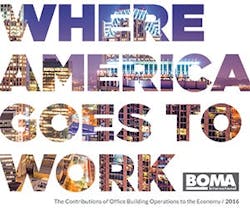BOMA Files
The best place to hide something is in plain sight. One U.S. industry that proves the saying is commercial real estate.
We are surrounded by clues to the true economic power generated by the massive inventory of U.S. office buildings. Hundreds of millions of people populate offices every day of the week. Yet the built environment goes mostly unnoticed – until an elevator breaks down or a pipe leaks. This lack of awareness, caused by the routine nature of going to work each day, can make it easy for office workers to lose sight of those who make their work possible – the property professionals who support tenants and keep the elevators and pipes functioning.
The Building Owners and Managers Association (BOMA) International recently released its biennial economic impact study, which reveals the power of the commercial real estate industry in the U.S. economy. According to Where America Goes to Work: The Contributions of Office Building Operations to the Economy, 2016, authored by Stephen S. Fuller, Ph.D., there are 1.75 million operational jobs supported by the commercial and government-owned buildings located in the markets represented by BOMA’s 91 U.S. local associations. Working mostly behind the scenes, these jobs span the entire life cycle of the 10.5 billion square feet of office space in BOMA’s U.S. markets, from pre-construction to daily operations and maintenance. Last year this economic engine generated ongoing operating costs of $89.1 billion.
In turn, that sum accrues additional benefits as it cycles through the local, state and national economies. The ripple effect extends from the office building out to the corner delicatessen, the local building supplies distributor and beyond, supporting significant direct and indirect job growth. As BOMA’s study highlights, for each dollar spent in building operations and maintenance expenditures, the U.S. economy gained $2.64. Ultimately, operational expenditures last year contributed approximately $235 billion to the national gross domestic product (GDP).
The $89.1 billion spent on operating office buildings also generated a total of $67.4 billion in new personal earnings as a result of both the jobs supported directly by this spending and those supported indirectly by re-spending these dollars for consumer goods and services. At the national level – where these annual building operating expenditures have their greatest cumulative impact – for each dollar spent on direct operating outlays, 76 cents of new personal earnings were generated.
And that doesn’t begin to scratch the surface. We can’t ignore the most critical mission of building operations – to support tenants, representing everything from the two-person tech startup to the international corporation. The 10.5 billion square feet of office space located within BOMA’s U.S. markets provides the “factory floor” for today’s economy; these productive workplaces are where much of the nation’s gross regional product (GRP) is generated each day.
In fact, assuming an occupancy rate of 85% and an average of 190 square feet per office worker, buildings in these markets provided workspace last year for an estimated 46.9 million office jobs. Roughly one-third of all U.S. workers work in BOMA office space. Additionally, each office worker produces an average of $109,332 in annual GDP value for a total GRP contribution of $5.13 trillion, which, in turn, accounted for 28.9% of the U.S. economy last year.
The economic benefits from construction end when a building is ready for occupancy. However, the benefits from annual building operating expenditures are just beginning. These benefits extend over the lifespan of the asset, supporting local vitality through the creation of new jobs, generation of personal income, and contribution to the local tax base year after year.
While commercial real estate is a national industry that hides in plain sight, its role as a major source of economic activity, jobs and personal earnings cannot be denied.
To download BOMA International’s full economic impact study and explore the role of commercial real estate in your state and local market, visit www.BOMA.org/EconomicImpact.
John Salustri is Editor-in-Chief of Salustri Content Solutions, a national editorial advisory firm based in East Northport, NY.
